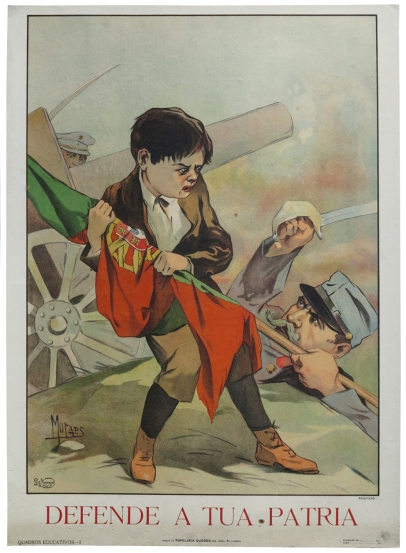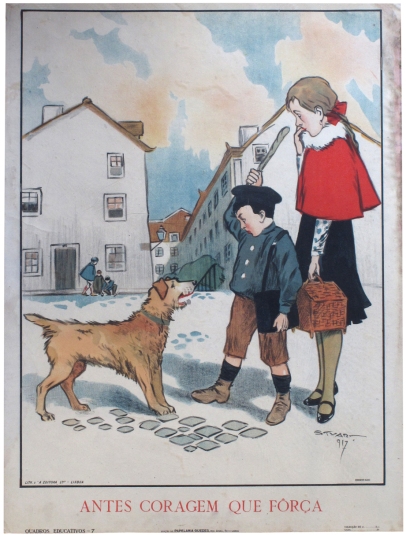As revoluções em Portugal têm destas coisas. Raramente os ventos de mudança penetram a cultura visual com a mesma violência com que o fazem na esfera política e social. Foi assim em 1974 com a proliferação da estafada iconografia soviética e chinesa, foi assim com a implantação da República em 1910. O novo poder político tinha em mãos uma sociedade rural e iletrada. Em 1917, às portas da ditadura de Sidónio Pais e de uma fraturante participação nas trincheiras lamacentas da Primeira Guerra Mundial, o regime empreende uma demanda pedagógica destinada a aplicar a moral republicana assente nos princípios humanistas consagrados pela matricial revolução francesa. Apesar da contemporaneidade da primeira geração modernista do Orfeu, onde pontuava Almada Negreiros, os 12 cartazes da série Quadros Educativos, que ornamentaram as paredes das escolas portuguesas, ficaram a cargo dos ilustradores e cartunistas académicos que seguiam as pisadas do oitocentismo, no traço piegas de dramalhões históricos de sabor romântico, na aguarela verista de costumes e usos tradicionais portugueses ou ainda no corrosiva sátira política de feição bordaliana. Os Quadros foram ilustrados por A. Quaresma, Hebe Gonçalves, F. Guedes, Hipólito Collomb, as manas Helena, Mamia e Raquel Roque Gameiro, Rocha Vieira, Alonso e Alberto Souza (que tanto irritou os modernistas de Coimbra com o seu obssessivo registo da ruralidade portuguesa), e ainda o prolífico Stuart de Carvalhaes, balançando entre a tradição e os modernos. O design dos cartazes é rudimentar e passou ao lado da revolução em curso no cartazismo publicitário que operava em toda a Europa uma síntese gráfica e só vingaria em Portugal no início da década seguinte. O traço verista, adoçado pela sumptuosa impressão em litografia, ilustra princípios de caráter laico e igualitário (Ama a Árvore / Ajuda os Mais Fracos / O Trabalho Dá Alegria / Respeita os Mais velhos / Quem Semeia Colhe / Devagar Que Tenho Pressa) e desígnios nacionais, como o impressionante cartaz de Alfredo Moraes com a exaltação patriótica da participação do Corpo Expedicionário Português em França, no expressivo dramatismo com que Morais ilustrou centenas de novelas de sabor popular. Os Quadros Educativos têm uma curiosa sequela, 21 anos depois, nos sete cartazes A Lição de Salazar, editados em 1938 para comemorar os seus dez anos no Governo. Tal como os inflamados cartazes da Primeira República, também estes pretendiam doutrinar os futuros cidadãos.
Republican lessons
This tends to happen to revolutions in Portugal. It’s rare that the winds of change manage to penetrate visual culture with the same force as they do the political and social spheres. This was the case in the April 1974 revolution with its profusion of rather stale Soviet and Chinese iconography, as well as in 1910 and the proclamation of the republic. The new political powers found that they had a rural illiterate society in their hands. In 1917, at the start of Sidónio Pais’ dictatorship and Portugal’s divisive participation in the First World War and its muddy trenches, the government embarked on addressing the pedagogical need to set up a republican sense of morality. This was based on humanist principles enshrined in the model set by the French revolution. Although this happened concurrently with the first modernist generation of Orfeu artists, which included Almada Negreiros, it was academically-trained illustrators and cartoonists who were chosen to create the 12 posters of the Quadros Educativos[Educational Charts] to adorn the walls of Portuguese classrooms. These followed in the steps of 19th-century artists and their tacky depictions of historical dramas that appealed to romantic tastes, with their verisimo watercolours of traditional customs and costumes and also with caustic political satire in the style of Bordalo Pinheiro. The charts were illustrated by A. Quaresma, Hebe Gonçalves, F. Guedes, Hipólito Collomb, the sisters Helena, Mamia and Raquel Roque Gameiro, Rocha Vieira, Alonso and Alberto Souza (whose obsessive depiction of Portugal’s country life so annoyed modernists in Coimbra) and the inexhaustible Stuart de Carvalhaes, who balanced tradition with modernism. The design of the posters is elementary and ignores the on-going transformation throughout the whole of Europe, but which only reached Portugal at the end of the 1920s, of graphical synthesis in publicity posters. Their realist drawing style was softened in sumptuous lithographic prints that illustrated secular and egalitarian principles (Love Trees / Help Those Who Are Weaker / Work Brings Happiness / Respect Older People / Those Who Sow Will Reap / Slowly Because I’m In A Hurry). They also showed Portuguese concerns such as the remarkable poster by Alfredo Moraes with its patriotic exaltation of the Portuguese Expeditionary Corps during the war in France and in the expressive sense of drama with which he illustrated hundreds of novels that appealed to popular tastes. There was an interesting development to Quadros Educativos some 21 years later in 7 posters entitled A Lição de Salazer [Salazar´s Lesson], which came out in 1938 to commemorate his tenth year in government. They were meant to indoctrinate future citizens in the very same manner as the inflammatory posters of the First Republic.
Fontes Sources
Portugal Século XX, Crónica em Imagens, 1930-1940, Joaquim Vieira, Círculo dos Leitores, 2000
Filed under: A. Quaresma, Alberto Souza, Alfredo Morais, Alonso, F. Guedes, Hebe Gonçalves, Helena Roque Gameiro, Hipólito Collomb, Mamia, Rocha Vieira, Stuart de Carvalhaes, A. Quaresma, Alberto Souza, Alfredo Moraes, Alonso, F. Guedes, Hebe Gonçalves, Helena Roque Gameiro, Hipólito Collomb, Mamia, Rocha Vieira, Stuart de Carvalhaes












